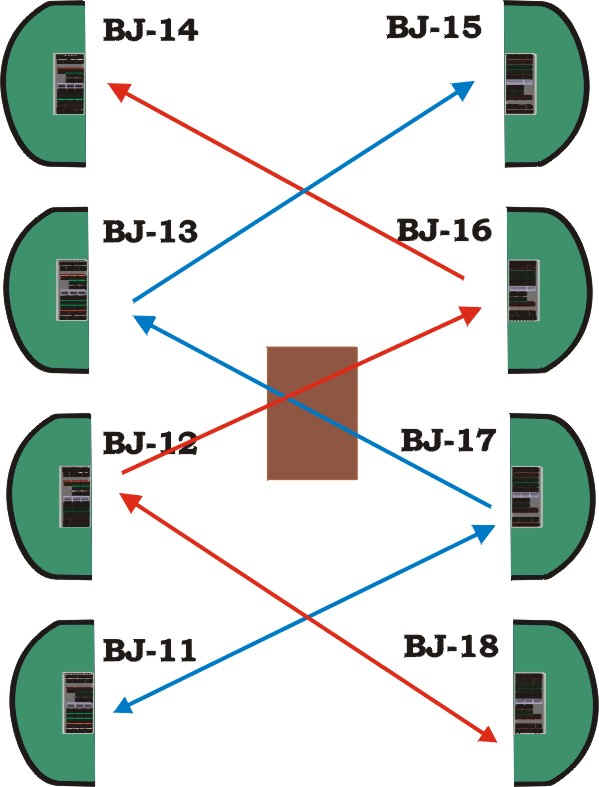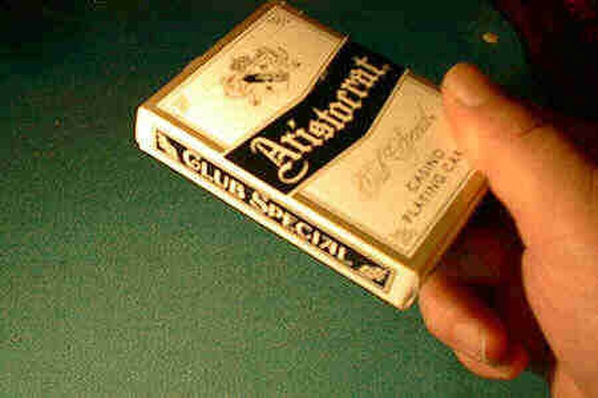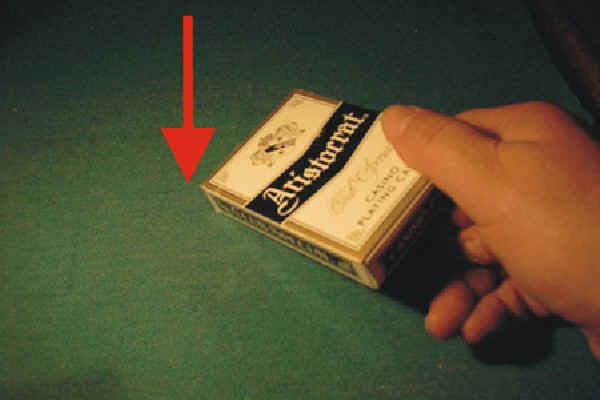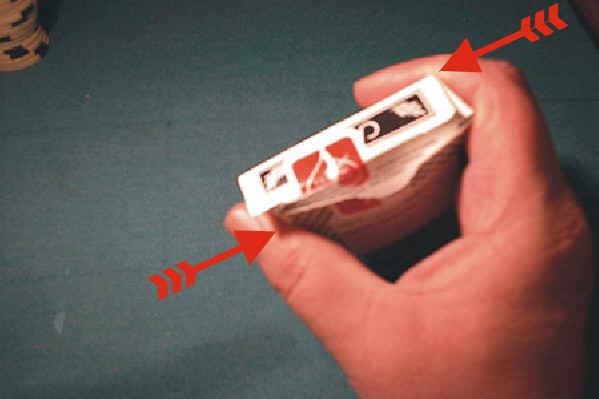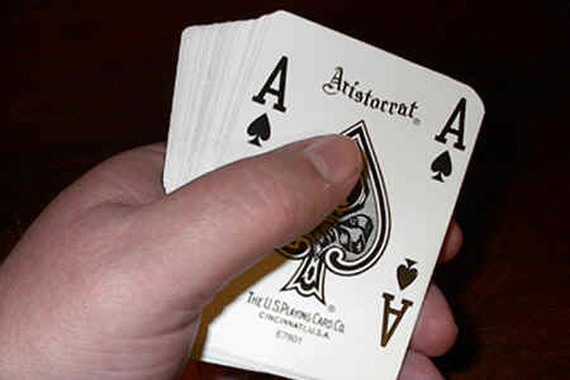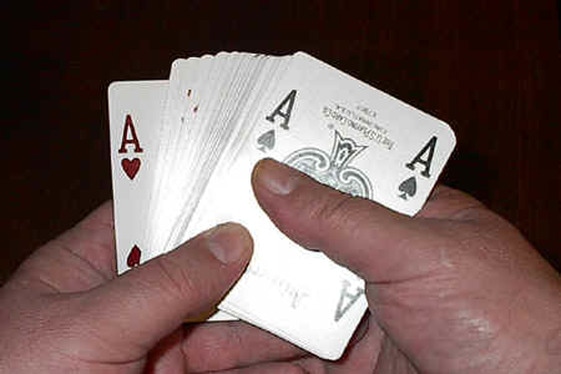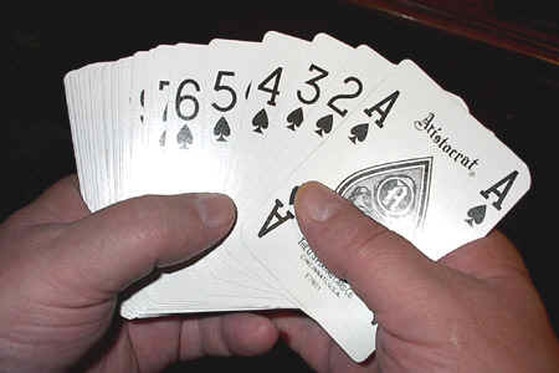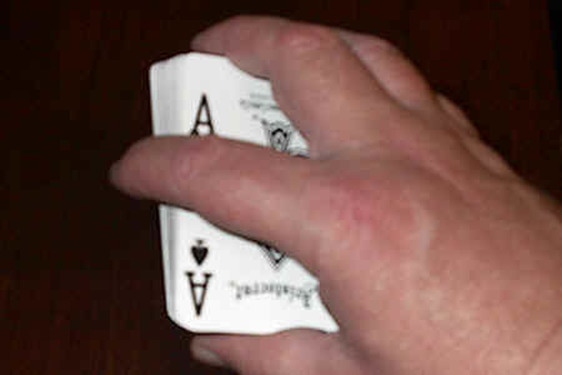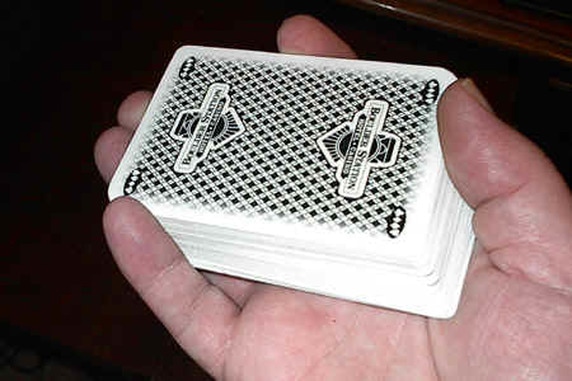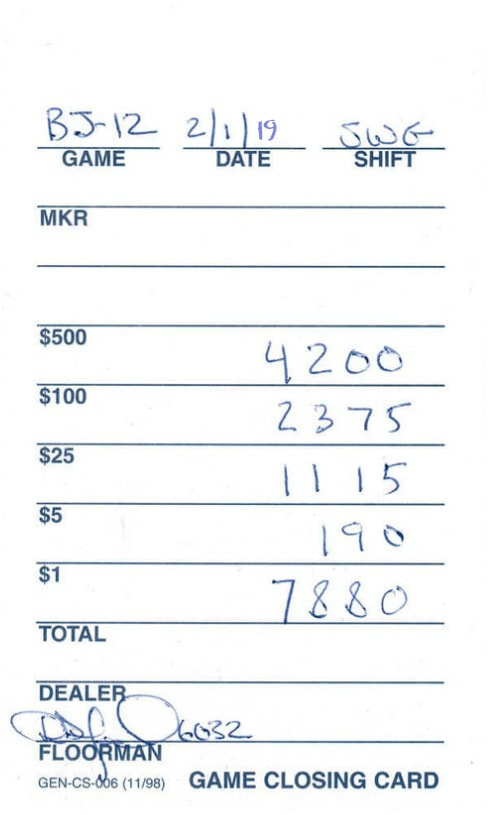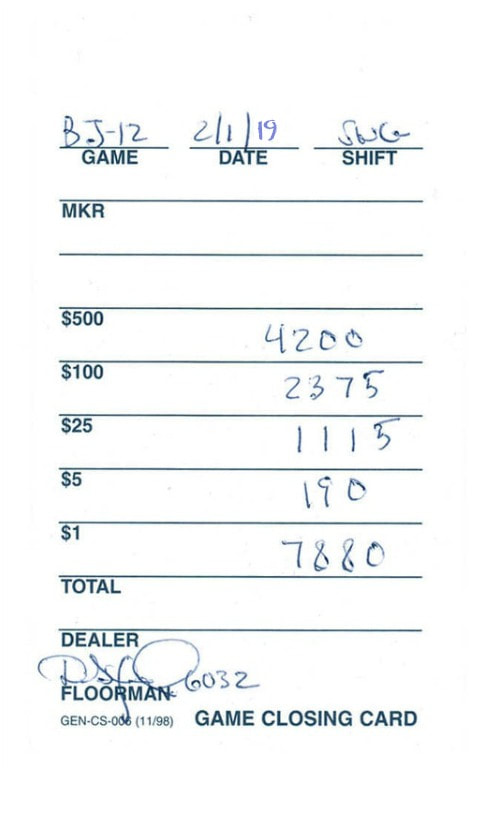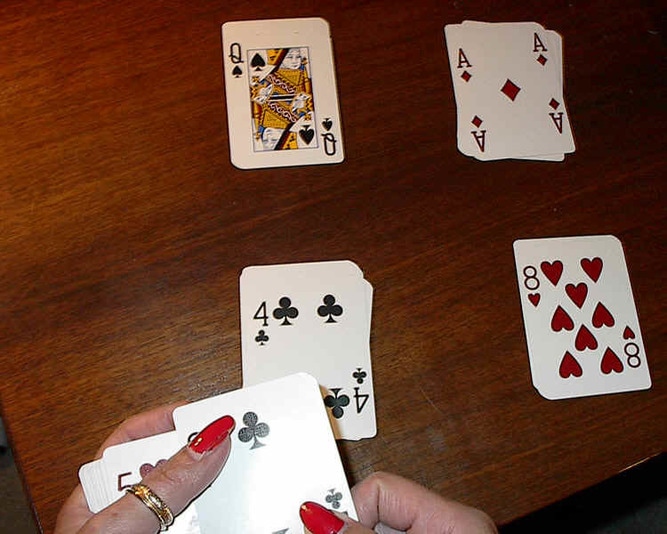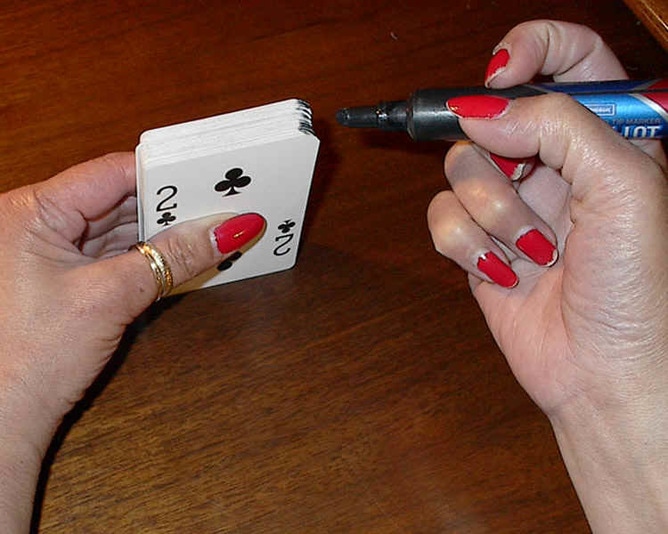Chapter 5
Continued Part 2
Opening Closing Games
Checking Cards Dice
Just as it is important to know how the spots on dice are supposed to be arranged on a die, it is important to know how cards are supposed to be arranged in a new deck of cards. Granted, it would take a scam worthy of Ethan Hunt, to alter or replace new cards sent from the factory but being prepared for such unlikely events is what supervisors are paid to do. A more likely scenario would be the case of manufacturer defects. In which case you would want to be able to point out any anomalies to your supervisor, before he points them out to you.
If a new deck of cards is removed from the box, the jokers removed and the deck is placed facedown on a table: what would be the card on the top of the deck? The answer is: the ace of hearts. If you picked up the deck, turned it over and looked at the bottom card, which card would it be? The answer: the ace of spades. Since the red suit of hearts is on the top of the deck and the black suit of spades is on the bottom and of course, the manufacturer alternates the suits by color, what suit follows hearts in the deck? The answer: clubs followed by diamonds. If the previous information is memorized, there is only one last bit of information that needs to be memorized and then the order of the cards can be remembered. Starting from the top of the deck: ace through king, ace through king, king through ace and king through ace.
Deciding what color deck to put on which table.
Deciding what color deck to put on which table.
When replacing decks on a live game, there isn’t a choice of which color to use. You must replace decks with another color in order to nullify an attempt by a crossroader that held out cards from the old deck.
But in the case of opening an entire pit, you want to make things difficult for anyone that might be tempted to exchange cards with someone on the next game. The easiest way to accomplish this is to put red decks on the even numbered games.
A couple of neat tricks for breaking the seal on a new deck of cards.
I remember the first time I tried to break the seal on a deck of cards, using one of the fancy methods used by my co-workers. By the time I got done, the only part of the box that was left intact was that goddamn seal! Of course if you were to ask another floorperson how they manage to open the box so easily, you are likely to get a vague or incomplete answer, that won’t be of any help to you. But not to worry, you have me here to help you.
Method one:
"Slam bam, thankee ma’am.
Grasp the deck using your thumb and index finger, on the bottom corner that is farthest from you. Make sure you have the side with the seal facing downward!
Drive the top corner, which is closest to you into the layout, with a snapping force. Your knuckles will probably hit the layout at the same moment. You don’t want to grasp the corner too tightly, since it is the cards in the box, rushing towards the lid, that breaks the seal.
Method two:
While looking down on the deck: use your thumb to push the bottom left corner of the box to your right, while using the crook of your index finger to push the upper right corner of the box to your left. This twisting motion moves the front of the box to the right, while leaving the lid in the same position. This motion tears the seal from left to right. This method is preferred when you are up against heavily glued seals that have a plastic like appearance.
Method two:
While looking down on the deck: use your thumb to push the bottom left corner of the box to your right, while using the crook of your index finger to push the upper right corner of the box to your left. This twisting motion moves the front of the box to the right, while leaving the lid in the same position. This motion tears the seal from left to right. This method is preferred when you are up against heavily glued seals that have a plastic like appearance.
Checking the cards.
It is vitally important to inventory the cards before putting them on a game. If the gaming commission would come in a casino and pull cards off of a game and discover there were cards missing, there could be serious legal ramifications as well as feeding frenzy for the media. NO JOKE
It is vitally important to inventory the cards before putting them on a game. If the gaming commission would come in a casino and pull cards off of a game and discover there were cards missing, there could be serious legal ramifications as well as feeding frenzy for the media. NO JOKE
Even though I intend to check all the cards, I’m going to make sure I haven’t made the common mistake of leaving an ace in the box. I check for the ace of spades on the bottom of the deck.
And I check the last card to insure it is the ace of hearts.
I now thumb my way through the entire deck, making sure every card is there. Even though it is the dealer’s and generally not the floorperson’s responsibility to check the back of the cards, I will sometimes check a few of them, especially when there have been problems with the manufacturer sending cards with uneven borders.
Upon completing the check, I will spread the deck on the insurance line, so the dealer can inventory the cards. Especially for those that have limited blackjack experience, I will show you a couple of subtleties that I have found helpful in achieving a good spread on the cards.
Upon completing the check, I will spread the deck on the insurance line, so the dealer can inventory the cards. Especially for those that have limited blackjack experience, I will show you a couple of subtleties that I have found helpful in achieving a good spread on the cards.
I straddle the upper-left hand corner between my index and middle fingers. My thumb supports the deck from the bottom.
Notice that my little finger is supporting the bevel I created with the cards. After I set the cards on the table, my little finger will continue to support the deck as well as slightly enhance the bevel. You will now put the jokers and ad cards back in the box and probably put them in the float lid. Make sure you put them at the end of the lid as close to you as possible, so the lid won’t have to be pulled out very far, in order to retrieve the boxes at the card change.
Closing down games.
Deciding when it is time to "start bringing up lids" a decision that involves a number of factors. The number one factor is the temperament of your shift manager. Some shift bosses like to delegate authority and won’t respect someone that has to call them and get permission to close games. Others are control freaks that don’t want any games closed unless they tell you to close them. In the case of the latter, control freaks sometimes don’t even want you to call them and ask if you can close a game. They prefer to waltz through the pit, waiving their scepter, issuing their royal decree to close games.
But even if you work for a boss that will allow you to make your own decision as to whether to close a game or not, if you don’t show good judgment, you might well lose the privilege. The worst case scenario is when the casino manager visits a pit and sees that there are patrons standing around the tables with money in their hand and no place to play. This usually occurs because there was not enough dealers scheduled, table minimums set too low or games are closed too early.
When it is late enough in the shift to start closing games but early enough to want games to accommodate players, you reach the point of where you will close one game, if you have two dead games. When possible, you want to close games in a way that will consolidate your pit into one easily watched section.
Later in the shift, when you have reached the point of needing to get games closed, you can remove the table minimum sign from a game and tell the dealer; "no new players please." At this point you might have to discreetly tell the dealer to pay players in larger denomination checks. Dealers, even those that desperately want to go home, sometimes don’t seem to grasp the concept that players with five hundred in red, can’t just get up and walk away.
When all else fails and the games haven’t died of natural causes, you will reach a point where you must close games. This is accomplished by calling "last shoe" "last shuffle" or "last shooter" on the remaining games. There is possibly no other time when your communicative and diplomatic skills are more tested. Your posture, tone of voice and choice of words must accomplish the goal of convincing the players that, although their patronage is appreciated, you must close this table.
One method I have found to be effective is to make an announcement prior to calling last shuffle. I will say something like; "Excuse me folks, I’m going to have to close this game in about ten minutes. There will be games in the main pit, that will be open all night." Not only does this seem to smooth out the situation but it often encourages people to beat the rush and find another table. There is another option that can be used when there is a dead game in the main pit. With the consent of the pit manager and the floorperson in that section, you can have the dealer bring up the lid on the dead game and wait for the players on your game to move over to it.
Procedures for closing tables.
The first thing to do when a game goes dead is have the dealer bring up the lid! Try not to get frustrated when the dealer decides to fix his rack first or put away the cards. Some dealers don’t understand that if a player would walk up before the lid is up, it might make it hard to turn him away. You then have the dealer fix his rack and then straighten his chairs. Meanwhile, you go get the key, so you are ready to lock the game as soon as you finish, get a closing slip (timestamp the back if necessary) and call surveillance.
Your conversations with surveillance should be pleasant, professional and to the point. As your only contact with the eye is over the phone, you should be careful not to say anything to offend them; "Hi, this is Dale. I’m closing BJ twelve. Thank you."
Completing the closing slip.
Deciding when it is time to "start bringing up lids" a decision that involves a number of factors. The number one factor is the temperament of your shift manager. Some shift bosses like to delegate authority and won’t respect someone that has to call them and get permission to close games. Others are control freaks that don’t want any games closed unless they tell you to close them. In the case of the latter, control freaks sometimes don’t even want you to call them and ask if you can close a game. They prefer to waltz through the pit, waiving their scepter, issuing their royal decree to close games.
But even if you work for a boss that will allow you to make your own decision as to whether to close a game or not, if you don’t show good judgment, you might well lose the privilege. The worst case scenario is when the casino manager visits a pit and sees that there are patrons standing around the tables with money in their hand and no place to play. This usually occurs because there was not enough dealers scheduled, table minimums set too low or games are closed too early.
When it is late enough in the shift to start closing games but early enough to want games to accommodate players, you reach the point of where you will close one game, if you have two dead games. When possible, you want to close games in a way that will consolidate your pit into one easily watched section.
Later in the shift, when you have reached the point of needing to get games closed, you can remove the table minimum sign from a game and tell the dealer; "no new players please." At this point you might have to discreetly tell the dealer to pay players in larger denomination checks. Dealers, even those that desperately want to go home, sometimes don’t seem to grasp the concept that players with five hundred in red, can’t just get up and walk away.
When all else fails and the games haven’t died of natural causes, you will reach a point where you must close games. This is accomplished by calling "last shoe" "last shuffle" or "last shooter" on the remaining games. There is possibly no other time when your communicative and diplomatic skills are more tested. Your posture, tone of voice and choice of words must accomplish the goal of convincing the players that, although their patronage is appreciated, you must close this table.
One method I have found to be effective is to make an announcement prior to calling last shuffle. I will say something like; "Excuse me folks, I’m going to have to close this game in about ten minutes. There will be games in the main pit, that will be open all night." Not only does this seem to smooth out the situation but it often encourages people to beat the rush and find another table. There is another option that can be used when there is a dead game in the main pit. With the consent of the pit manager and the floorperson in that section, you can have the dealer bring up the lid on the dead game and wait for the players on your game to move over to it.
Procedures for closing tables.
The first thing to do when a game goes dead is have the dealer bring up the lid! Try not to get frustrated when the dealer decides to fix his rack first or put away the cards. Some dealers don’t understand that if a player would walk up before the lid is up, it might make it hard to turn him away. You then have the dealer fix his rack and then straighten his chairs. Meanwhile, you go get the key, so you are ready to lock the game as soon as you finish, get a closing slip (timestamp the back if necessary) and call surveillance.
Your conversations with surveillance should be pleasant, professional and to the point. As your only contact with the eye is over the phone, you should be careful not to say anything to offend them; "Hi, this is Dale. I’m closing BJ twelve. Thank you."
Completing the closing slip.
The first thing you do upon arriving at the game is to fill out the peripheral information (game, date and shift). You do this so you can’t forget it and so if you make a stupid mistake, you have more time to catch it.
Next, you fill in the amounts, double-checking them as soon as you finish. You will now total the amounts. I find it useful to add the numbers backwards, when I double-check the total, as this will reduce the likelihood of me falling for the same mental error twice. You are now ready to sign the slip and give it to the dealer so he can check and sign it.
At this point you are now looking around for another suit to give you a "third" (a third check and signature). You can now go find something else to do, since you had the foresight to leave the key on the game, the supervisor that does the final check can lock the game. What you will probably need to do is to watch that supervisor’s section as well as your own.
Next, you fill in the amounts, double-checking them as soon as you finish. You will now total the amounts. I find it useful to add the numbers backwards, when I double-check the total, as this will reduce the likelihood of me falling for the same mental error twice. You are now ready to sign the slip and give it to the dealer so he can check and sign it.
At this point you are now looking around for another suit to give you a "third" (a third check and signature). You can now go find something else to do, since you had the foresight to leave the key on the game, the supervisor that does the final check can lock the game. What you will probably need to do is to watch that supervisor’s section as well as your own.
Don’t hand anyone a piece of shit like this! Just try to add up the amounts without suffering vertigo. Make sure all your amounts are "justified right." Write the total of the drop in the drop section of each game, as you close it. This is especially important in roulette, when the dealers use lammers to mark up the drop, as you don’t want someone to have to unlock the game later, to record the drop.
Canceling cards and dice
Canceling playing cards is a three-part process. The first part involves inventorying the cards. Under the strictest of circumstances, you will need to sort the cards and reconstruct them into the order they were in, when they came out of the box.
Canceling playing cards is a three-part process. The first part involves inventorying the cards. Under the strictest of circumstances, you will need to sort the cards and reconstruct them into the order they were in, when they came out of the box.
I sort the cards in the same fashion, every time I do it. This makes me a little faster, every time I do it. I put the red cards on the right and black cards on the left. I put spades and diamonds on the top.
If inventorying the cards isn’t required, you will probably have to count them and put fifty-two in a box. Sometimes, you are required to count the aces, since this would be the card most likely held out by a crossroader.
If inventorying the cards isn’t required, you will probably have to count them and put fifty-two in a box. Sometimes, you are required to count the aces, since this would be the card most likely held out by a crossroader.
Canceling cards usually involves marking opposite corner with a felt tip pen. The next corner she will mark will be the corner that is now bottom-left. The last step in the process involves writing some information on each of the boxes. This can be written on the outside of the box or on the inside of the flap. The information that is usually required is: the date, the game, the time the cards were taken off of the game, your name and ID number and the dealer’s name.
Make sure you check dice for miss-spots when you take them off the game. Dice are usually cancelled with this type of device, the center of the "four" side being the most popular choice. Remember, you aren’t drilling for oil, if you overly enthusiastic in this procedure, there is a good chance that you will strip out the threads of the canceling device. Wrap the dice in the wrapper they came in but use the wrapper inside out and use tape to seal it. You might also be required to write the time you took the dice off of the game, on the wrapper.
So now your pit is closed and all that remains to do is check all table lids, one more time, to make sure they are locked. If any are discovered unlocked, you must call surveillance before locking them.
So now your pit is closed and all that remains to do is check all table lids, one more time, to make sure they are locked. If any are discovered unlocked, you must call surveillance before locking them.
Site created and designed by
Scott Cameron
Las Vegas, Nevada
Scott Cameron
Las Vegas, Nevada
Email me [email protected]
Copyright 2020-2024
Last update 3/18/2024
Last update 3/18/2024
Visit my other website...



